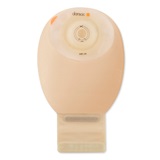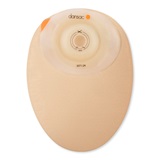Preventing a Peristomal Hernia
A peristomal hernia can occur at any time after stoma surgery. Learn what a peristomal hernia is and how to prevent it.

Learn about peristomal hernias.
A peristomal hernia (also known as a parastomal hernia) is a common complication that affects many people with stomas. However, not everyone with a stoma develops a peristomal hernia.
A peristomal hernia can occur weeks, months, or years after stoma surgery. The risk of developing a peristomal hernia increases with age. Other risk factors include surgical technique, muscle weakness, and multiple abdominal operations. Being overweight, coughing, or straining can also increase the likelihood of a peristomal hernia.
What is a peristomal hernia?
A peristomal hernia forms because of a weakness in the abdominal wall that allows the abnormal protrusion of an organ or part of an organ (usually the bowel). The weakness is the reason that a peristomal hernia appears as a bulge around the stoma. Skin surface irregularities and tension around the stoma can occur as well, depending on the hernia’s size and shape.
 A parastomal hernia |
|
 Sideways view of a hernia formation |
The size and shape of a peristomal hernia will change depending on your position. For example, it may become less visible when you are lying down. Peristomal hernias may be very small or quite large.
A peristomal hernia usually develops slowly. Many people don’t realise they have a hernia until they see their stoma care nurse or surgeon. Some find the appearance of a hernia to be very distressing, so it’s important to understand why hernias appear and how to prevent them.
Tips for preventing a peristomal hernia
The risk of developing a peristomal hernia due to straining when lifting or strenuous exercise is generally higher than the risk of developing a groin hernia. This is because muscles are cut during surgery to make the stoma, which may make them weaker after the procedure.
To help prevent a peristomal hernia, you can:
- Avoid lifting anything heavier than 2.2 kg (5 lbs.) for up to six weeks after surgery. If necessary, use a wheeled trolley to help move heavier items, or get someone to help you.
- Perform gentle exercises. Do abdominal stretches, or pelvic lifts, or walk. Sit-ups, crunches, or any other abdominal muscle exercises must be controlled and done very carefully. Your stoma care nurse will give you advice on the most appropriate exercises for you to do – both before and after your surgery.
- Manage your weight. Stay within an appropriate weight range.
- Wear supportive underwear, if recommended. If your stoma care nurse feels you require some additional abdominal support, they will discuss this with you and provide the appropriate garment to meet your needs.
If you suspect you have a peristomal hernia
If you think you may have a peristomal hernia, see your stoma care nurse. He or she will assess your abdomen and provide you with management options.
- 2 Shares
- 78 Recommended





